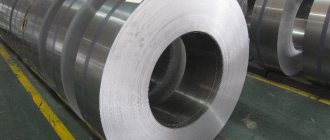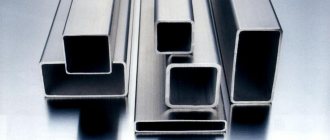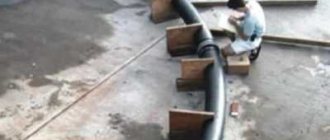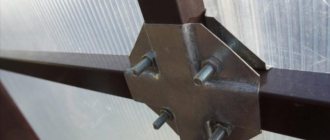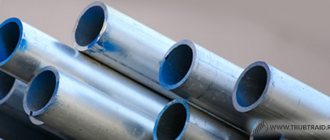Possible complications during work
The actual bending of such a pipe is the process of giving the element a curved-smooth configuration. This can only be done under pressure, since the part has high strength. To reduce the pressure force required for bending, you can use heating of the bent fragment.
Despite the apparent simplicity of the operation, bending does not always result in elements of the desired configuration. Problems arise quite often. The most common complications include three.
The first is that the inner side of the profile folds in peculiar folds that resemble corrugation. In the correct version, it contracts evenly.
The industry produces many types of profile pipes. They differ in cross-sectional shape, profile height, wall thickness
The second difficulty is the rupture of the outer wall of the profile pipe. During bending it stretches. Sometimes the metal cannot withstand the force and bursts. The third problem is that the pipe, changing its shape, can lose the alignment of the elements.
This means that its fragments in a bent state will lie in different planes. And this is unacceptable. Practice shows that all difficulties occur due to the wrong choice of bending method.
To choose it correctly, you need to take into account the plastic capabilities of the profile pipe. They are determined by the size and shape of the section, as well as the thickness of the walls of the product. Based on these values, you can calculate the minimum possible radius of curvature. Trying to make a round with a smaller radius is strongly discouraged.
To determine the minimum radius, we need the height of the section. It is calculated as follows. The height of the profile is measured, and twice the wall thickness of the product is subtracted from it.
The resulting number will be the desired height, let's denote it h. For pipes with a cross-section in the shape of a rectangle and square, the following rule applies. If the profile height is above 20 mm, the part can withstand bending in a section whose minimum length is hx3.5.
Products with a profile below 20 mm can be bent over a length of hx2.5 or more. This rule applies to all pipes. However, the wall thickness of the part also affects bending limitations.
The thinner it is, the higher the likelihood of a rupture or crushing of the part. Experts strongly do not recommend trying to bend wide products with wall thickness less than 2 mm. In this case, it is optimal to use a welding machine.
When bending a profile pipe, it is very important to perform all actions correctly and carefully, otherwise the part may lose alignment or become wrinkled. This pipe cannot be used
One more thing to be aware of. Pipes made of low-alloy and carbon alloys are very elastic and, after bending, can seem to “spring”, trying to take their previous shape.
This involves additional work with the product, since it will have to be adjusted again according to a pre-made template. Therefore, it is recommended to find out the value of the plastic moment of resistance of a given profile pipe and carry out bending taking this indicator into account. The smaller it is, the less the part will “spring”.
Bending fixtures and machines
The family of bending devices and units includes representatives of varying degrees of technical complexity. First, let's look at the tools for those who are puzzled by the question of how and with what help you can bend a profile pipe without the use of special equipment. Then we'll move on to homemade rolling rigs.
Options for simple devices
The use of elementary “helpers” for cold deformation regulates the dimensions of the material:
- thin pipes with a profile height of up to 10 mm are bent using a horizontal plate with holes. Metal pins are rigidly installed in the holes, acting as stops. Bend the product by placing it between stops installed in the holes according to the bending radius. Start from the middle of the workpiece and gradually move towards the edges. The disadvantages of the method are the application of considerable muscle effort and the rather low accuracy of deformation;
- pipes with a profile height of up to 25 mm are bent using roller devices operating on the principle of a Volnov machine. The metal workpiece is firmly fixed in a vice, and physical force is applied to the workpiece through a roller. Bending is performed better and more uniformly than in the previous case. But by analogy, considerable effort will be required from the performer.
To form a bend with a large radius of curvature, such as arcs for an arched frame, stationary round templates with clamps are used to fix the workpiece. These devices belong to the category of plane-parallel plates. The workpiece is forcefully “placed” into a groove whose dimensions are equal to the dimensions of the pipe. The pipe, bent manually using a mandrel, takes the shape of a given contour.
Upgraded bending plate
If a home mechanic is not deprived of physical strength, for his own needs he will need a simple tool for the rather labor-intensive deformation of a profile pipe. It can be made in the form of a panel attached with clamps to a desktop or workbench. In the case shown in the photo, the bending plate is welded to a metal pedestal, but it is screwed with four bolts to the concrete floor of the workshop. To remove the device upon completion of work, it will be enough to unscrew the bolts. After dismantling, no fastening pins remain and do not rise above the floor surface, which means that nothing will interfere with movement and create traumatic threats.
The principle of manufacturing a working plane is extremely simple:
- The bending plate is a panel cut from thick sheet iron.
- The panel is welded to a profile pipe, installed according to telescopic rules in the pedestal stand.
- Two holes were drilled in the working plane for bolts, which act as stops.
- The bending radius is adjusted by installing nozzles of a suitable size on one of the bolts.
- In order to maintain the alignment of the sections adjacent to the bend, a metal plate is installed above the workpiece, secured with bolts.
The pedestal is multifunctional. Its owner has the opportunity to use it as a miniature workbench to perform an impressive number of plumbing operations.
Mandrel for bending profile pipes
The method is suitable for products with a wall height of up to 25mm. The craftsman will need a large workbench and a significant amount of free space around the work area. One edge of the workbench is perforated with frequently spaced holes for fastening the mandrel and for selecting the optimal position of the part fixing the pipe. A template for the upcoming plastic deformation is cut out of thick plywood. True, the plywood mandrel is suitable only for one-time bending procedures. If there is a lot of bending work to be done, it is better to weld the mandrels from angle steel.
Features of different profile bending methods
There are two main methods of bending profile pipes: cold and hot. The first assumes that the bending process is carried out without preliminary temperature exposure to the part.
While the second is carried out only with a preheated pipe. It must be admitted that heating the part significantly increases its ductility and facilitates the bending process.
There are no standards strictly regulating the use of cold and hot bending methods for profile products. They are only available for pipes with a round cross-section. According to these standards, hot bending is used for parts whose diameter is 100 mm or more. For rectangular and square pipes, slightly different rules apply.
If you have a one-time job of bending a pipe, you can buy, but it is better to rent a hydraulic pipe bender with a manual drive:
Image gallery
Photo from
Manual hydraulic pipe bender
Replaceable bending segment
Devices for fixing a bent pipe
Bending steel pipes with high force
Plumbers recommend cold bending only all pipes with a profile height of less than 10 mm. Products with a profile height of 40 mm and above are hot bent.
How to bend parts with a profile height from 10 to 40 mm is up to the performer to decide. To avoid mistakes, you can perform a trial bending. In general, if you have a pipe bender, you can use it to bend the pipe without any heat.
If there is no special tool, it is worth performing a trial bending of the profile pipe. To do this, one edge of the part is firmly clamped in a vice. A pipe with a diameter larger than that of the product being bent is put on the other end.
The resulting “shoulder” should be pulled strongly, bending the product. If the part bends, you can use the cold bending method. If not, bending with preheating is used.
Now let's look at how to bend a pipe using a pipe bender
When constructing complex buildings, square and round profiles with thick walls are used. They are difficult to bend by hand, so a pipe bender is needed. There are two types of machines:
- Manual. The devices are of simple design and inexpensive. Quite suitable for use on the farm.
- Automatic. They are classified as professional and are used by specialists. They are expensive and therefore not suitable for home use.
Photo - mechanical profile bender
Also, the machines differ in operating principles and come in different models. Let's look at the most practical ones:
- Crossbow pipe bender.
- Spring pipe bender.
- Segmental pipe bender.
- Mandrel pipe bender.
Working with a pipe bender is convenient and easy. It holds the profile securely and exerts uniform pressure on it. The bending radius can be adjusted. The output is perfect arcs.
Subtleties of hot bending
Bending of a fragment of a profile pipe occurs after it is heated. It is advisable to perform the operation in one approach, since repeated heating of the metal is undesirable. A product that has cooled to a light cherry color may rupture.
Therefore, this method is ideal for performing a single corner bend. To bend a profile into a rounded arch, it must be used with caution, since repeated heating in this case is inevitable.
It is good to use sifted and calcined sand as a filler for pipes during hot bending. It is poured inside the part using a funnel
To correctly bend a profile pipe using a hot method, you should use a filler. This will prevent possible crushing of the part. Sand is usually used as a filler.
The best option is medium-grained construction sand. If this is not available, material from a children's sandbox will do. First, you need to clean it of unnecessary impurities.
To do this, sand is sifted through a sieve with cells measuring 2-2.5 mm. This will help you get rid of large pebbles and debris. If during the bending process such an inclusion ends up directly next to the pipe wall, it will form a relief that is completely unnecessary.
Too small grains of sand are also not needed. During the heating process, they can sinter, which is undesirable. Therefore, the sand will have to be sifted again, this time through a fine sieve. Its cell size should be about 0.7 mm. We calcinate the sifted sand.
The filler is ready. Now you can work on the detail. First you need to anneal the pipe in the area where bending will be done. Then you can start making the plugs.
You will need two parts of the same size that will cover both ends of the profile pipe so that the sand in it does not spill out. The plugs are made only from wood; no other material can be used.
Let's decide on the size and shape of the parts. These must be pyramids, each ten times longer than the width of the base. The dimensions of the base itself should be almost twice the size of the hole that will be closed with this plug. The prepared products need to be tried on the pipe.
The profile pipe is closed with wooden plugs. In one of them, recesses must be made to allow the release of gases formed inside the heated part.
If everything is fine, we make a longitudinal groove on each side of one of the plugs. The gas accumulated during heating will escape from the workpiece through these grooves. You can start filling the pipe.
To do this, take a plug without grooves and install it in place. A regular funnel is inserted into the opposite end of the part. If the pipe is long, it is placed at an angle to the ground, if it is short, it is placed perpendicularly.
Sand is poured in small portions through the funnel. After each portion, take a rubber or wooden mallet and thoroughly tap the part from below, helping the sand to be distributed as evenly as possible and compacted. Once a dull sound is heard when tapping along the entire length of the pipe, work must be stopped. This means that the part is completely filled with sand.
The sand-filled workpiece is closed with a second plug. Now you need to chalk out the boundaries of the area that will be heated. Its length must be equal to at least six workpiece diameters.
The part is securely fastened in a clamp or vice. If the pipe is welded, it must be secured so that the seam is outside the bend. If it is inside, the part may burst.
Now you should heat the pipe fragment to a red-cherry color. This can be done with a blowtorch or a gas soldering torch. Important point. The entire area should be heated evenly.
Do not allow individual fragments to overheat. If this does happen, such areas should be cooled. An indicator of a sufficiently heated pipe will be scale bouncing off it.
Experts strongly recommend performing hot bending of a profile pipe in one step. Repeated heating of a part can lead to its rupture
After the workpiece is heated, a piece of pipe with a larger cross-section is put on its end. So that the edge of the part does not reach the future bend a little. After which the pipe is carefully bent to the desired shape.
This must be done in one step with a smooth translational movement in a vertical or horizontal plane. The resulting bend is checked against the template.
The bent pipe must cool, after which it should be compared again with the template and make sure that the given shape is correct. If so, the plugs are knocked out. This is often difficult to do, then you can simply burn out the wooden plugs and pour out the sand.
To ensure a clear bend, without folds or tears, you need to pack sand into the pipe as tightly as possible and heat the part evenly.
How to bend a square pipe
To bend square reinforcement you need a bending machine. You can make it yourself. It does not have a complex configuration and is equipped with:
- profile fixed roller;
- wrapping roller;
- long lever.
This type of pipe bender is considered the simplest, yet very practical. To bend the profile, you must:
- insert the reinforcement between the rollers at the bend;
- Having provided the workpiece with a reliable stop, press the lever;
- the enveloping roller begins to press and bend the workpiece.
In this way, the reinforcement is bent at any necessary angle. Video: bending a square metal profile
Overview of species
Those who install various metal structures need to use a profile bender. Now it has become fashionable to install beautiful greenhouses made of metal profiles on your site. They are reliable. Therefore, for greenhouses, canopies (arched), namely for their manufacture, a manual profile bender is quite suitable. It is small and can be installed in any room intended for various construction works.
To bend profiles with tension, you can use a machine that operates on the principle of the PGR-6 machine. This product has a stretching mechanism designed for bending aluminum alloys along contours that are not closed. In a profile bender, the number of rolls plays a major role. The simplest design consists of 2 rolls. Such models are used for very light work.
The number of rolls and versatility determines what type a particular machine can belong to. Some rolling products can rotate rolls only in one direction, while others can rotate rolls in both directions at once. Therefore, in the first case, the machines are not called reversible, but in the second - reversible.
Consider, for example, a three-roll roll forming machine with hydraulic movement of the top roll. In it, the profile is fixed between the rolls. All of them have hydraulic engines and attachments (suitable for any cross-section). The required radius is ensured here using a hydraulic drive. Therefore, these products are in good demand where a machine is needed for the production of simple products.
Using profile benders of different directions, you can make various configurations from metal that differs in radius. They are capable of producing parts of various curvatures with both asymmetrical and symmetrical contours. In more detail, profile benders have the following types.
- Pneumatic profile benders operate using pneumatics.
- There are hydraulic profile benders.
- There are also manual, mechanical and electromechanical profile benders.
By placement method
Profile benders are placed on different flat surfaces. Too large specimens are installed on the floor in a spacious room. Due to their enormous weight, they can only be used in workshops. Such models have an electric drive and operate from the network. Other specimens must be secured using special devices to prevent their involuntary movement. This category of machines is intended for work both on an industrial scale and for individual use. Industrial machines are used for bending where large-scale work takes place. So, there are mobile machines, and there are stationary ones. Each of them has either manual or automatic material feeding.
In most cases, specialists use manual profile bending machines. Some people make them with their own hands. This option is quite affordable. But there are also disadvantages. For example, it is inconvenient to perform several bends on one profile at once. It is also difficult to work with such products due to the heavy load on a person. In addition, the bending time increases and it is impossible to control the bending radius.
By drive type
Roll benders are classified as follows.
An electric profile bender, when compared with a manual one, can operate at a fairly high speed. It is also distinguished by the accuracy of its work. Using such a device, you can bend very strong metal products. It can process any types of profiles, even such as I-beams and round products.
Deformation with internal resistance
For those who are looking for methods on how to bend a pipe at home without corrugation, a method with an internal spring is suitable. We wind it on some suitable workpiece so that the outer side of the spring passes along a profile pipe with a gap of 1-1.5 mm along the entire length of the deformed part. We use wire with a diameter of 1-3 mm, depending on the parameters of the bent pipe.
We warm up the treatment area with a propane torch or blowtorch. Then we insert the pipe being processed into a pre-made matrix with an internal through hole that provides the required radius of curvature. The ratio of the size of the profile pipe and the hole must be taken into account.
The traditional option is one in which sand plays the leading role. It fills the free space inside the profile before bending the pipe. Both free holes will need to be plugged with wooden plugs. You will need clean dry sand. The size of the faction does not matter.
For a small diameter pipe, the use of preheating and river sand is mandatory, otherwise it will burst. Subsequently, they are burned out with a torch, and the sand is poured out.
It is also heated, put on a blank with the required radius and carefully bent. The pipe can cool either in natural conditions or in a bucket of water. This does not have any effect on quality and strength.
As you can see, even in artisanal conditions it will be possible to achieve maximum results. You just need to decide on the processing method and the necessary tools.
Main design elements
Principle of operation
To manufacture a particular machine design, you should look through several diagrams to determine the set of parts. The fact is that, if necessary, all the components of the units can be purchased for money, but you can also use the materials that you have on your farm and not pay anything for it. In most cases, home craftsmen opt for frontal structures, and for this you must have:
- three metal rollers (rollers);
- drive chain;
- axes of rotation;
- drive mechanism;
- metal profiles (channels) for the frame.
Sometimes, in the absence of metal rollers, they are replaced with wooden or polyurethane ones, but... Such a rolling mechanism will not withstand long-term load, that is, the machine will serve its purpose, but not for long. Is there any point in wasting your labor for short-term benefit if, with some effort or even paying a certain amount, you can find steel rollers?
Diagram of a simple pipe bender with dimensions in mm
As you understand, the process of profile deformation occurs using rolling, that is, the pipe is rolled over rollers (rollers), which eliminates breaking and cracking. To roll (bend) a profile, it is inserted into the rolling line (between the rollers) and pressed from above with a screw device or a jack to the desired bending radius. Then, when the feed handle is rotated, the pipe moves and the bend runs along its entire length. It turns out that this is a manual drive, which is driven by muscular force, but at home such a mechanism is very convenient.
The profile is pressed using a jack
To assemble the simple pipe bender in question with your own hands, you will need:
- jack (preferably rack and pinion type);
- metal profiles with a shelf for horizontal and vertical frames;
- springs made of alloy steel (they are distinguished by high strength);
- three steel shafts with bearings;
- drive chain (can be from a bicycle or moped);
- gears (driver and driven);
- Thick reinforcement for axles and drive handle.
Video: pipe bending process
As you can see, it is easier to make a profile bending machine with your own hands using the existing drawings, and photo and video materials only help with this. The profile bender shown in the picture is driven by a handle that rotates the shaft with the drive gear. Using a chain, rotation is transmitted to the shaft with the driven gear, and the third shaft presses the profile from above to the required bending angle. Everything is very simple.
Mechanism manufacturing process
Bending device drawings
If you are interested in how to make a profile bender, then you will have to perform a number of actions that will ensure this reliability of the mechanism, and this is:
- production of a powerful frame assembled using welding and bolt ties;
- according to the terms of the drawing (technical specifications), make and install rotation axes for the rollers. There are three of them - two rolling and one clamping;
- To rotate the rolling rollers, you need to provide a chain transmission, that is, weld (evenly) the drive and driven gears;
- Weld a handle for rotation onto the drive gear.
Manufacturing nuances
Ready pipe bender
If you have all the necessary parts available, then making a mechanism for bending the profile is not difficult. First of all, you need to take into account that all rollers must rotate on bearings - the accuracy of rotation will ensure correct rolling, without failures or breaks. The drive and driven gears must be correctly centered - a deviation from the center by at least 0.5 mm will lead to incorrect deformation (the bend will be uneven).
The pressure shaft must also be centered - the accuracy of the bending angle depends on this. It is best when the dimensions of all three shafts are the same - the rental results in the clearest. The rolling accuracy also depends on the rigidity of the clamp, so the shaft must be well fixed.
Disadvantages of homemade machines
- The difficulty is in minimizing the error in the bending radius of the workpiece.
- Limited bend radius.
- Working on such machines is very difficult, so performing a large volume of work is simply impractical.
- Difficulty in bending pipes and workpieces with a large cross-section.
- Difficulty in changing the shape in different areas of the workpiece.
If there is a need to work with parts that have a small cross-section, you can get by with a simple profile bender, consisting of two pins and a base. When thicker parts are deformed, you should pay close attention to their design features
Particular attention is required when working with pipes, because for them there is a dependence of the maximum permissible bending radius on the wall thickness. In the public domain you can find special memorial tables for choosing the maximum radius
Despite the fact that the process of making a machine with your own hands may seem overly complicated and will scare off many, the savings compared to buying a finished product can reach several tens of thousands of rubles. This argument in favor of homemade profile benders can be called very powerful.
Drawing of a typical machine
Now you can find many designs of manual profile benders, which can be made from simple parts with your own hands and without special skills. One of the simplest drawings of a profile bending machine allows radial bending of pipes and rectangular profiles. The need for just such a bend of the material arises most often.
Drawings of a homemade profile bender
The operating principle of such homemade equipment is based on the use of three rollers - two support rollers and the main working one. It is this working roller that will deform the pipe during the operation of homemade equipment.
The main working shaft must have a small free play, which will be limited by the parameters of the guides. For the manufacture of such structural elements the following are used:
- steel plates up to 8 millimeters thick;
- one large plate;
- steel corner 30 cm long - 4 such elements are needed;
- auxiliary rollers.
Auxiliary rollers are attached to the large plate using bolts, and corners are attached using a welding machine, which will act as guides.
To increase the strength and reliability of the base, two steel corners should be welded to its bottom. To strengthen the guides, a metal plate with a hole is attached to them on top using a welding machine. Its diameter must exceed the cross-section of the screw, which will exert the main load on the working shaft of a hand-made manual profile bender.
After completing the installation of the guide rollers, the bending machine will be ready for work, and you can use it to shape pipes and rectangular profiles into any configuration with your own hands.
Safety precautions
It is better to prepare a separate room for performing twisting and all other operations with metal products.
A garage or workshop is suitable, because in addition to the structures themselves, for work you will have to use, for example, a blowtorch or an argon gas torch, impact or cutting tools.
The work site must be ventilated and free of clutter. Otherwise, sparks during cutting or careless handling of a heat source when heating the metal can lead to fire and smoke.
The experts also advise taking care of special clothing. An apron and mask will protect from small fragments and dust, and mittens will protect from temperature influences and possible cuts. If you have to use an angle grinder, special glasses will be an essential element.
Protection against ovalization
The main methods of cold bending a galvanized pipe involve measures that allow the workpiece to be bent while preserving the shape of its cross-section as much as possible. Typically one of two methods is used for this:
- The use of measures to preserve the shape of the section from the inside (use of an internal limiter).
- Using an external stop to prevent expansion of the side walls.
Rigid materials as fillers retain their shape better, so they are used more often. But thanks to the use of elastic fillers, less stretching of the outer surface of the bend occurs.
on the topic
Experienced summer residents and owners of their own houses have long appreciated the versatility and convenience of profile iron pipes. They are used in the construction of porticoes, extensions and gazebos, and are also used as struts for greenhouses and greenhouses. They are also often necessary in the manufacture of decorative parts.
When using corrugated pipes in home construction, they are usually bent to give the desired shape. There are several common ways in which you can perform this operation without purchasing special equipment such as a pipe bender.
Bulgarian
A unique method of bending a professional pipe is to use a grinder.
To make an angular twist, 2-5 transverse cuts are made at the intended point on the inner surface of the workpiece with a grinder, without touching the outer wall.
READ angle grinder which is better
Their number directly depends on the size of the angle - the larger it is relative to the straight line, the more notches are applied.
After the notches are made, the profile can be carefully and easily bent, and the notch areas are welded using a soldering iron or welding.
If later, when the pipe has cooled, you grind and sand the welding points, the profile will correspond to the shape desired by the master.
Bending spring
All masters know about this method. Its essence is as follows: a special square spring made of steel wire is placed inside the pipe in the place where it is necessary to obtain a bend. The spring will serve as a mandrel; its cross-section should be 1-2 millimeters smaller than the internal cross-section. Using a blowtorch, the place of further bending is heated, applied to the blank with a suitable bending radius and, using force, not sharply pressed until the desired curvature is obtained. This method is quite simple, but when using it when carrying out work, it is recommended to carefully observe safety precautions: work in special gloves and use pliers.
Types of pipe benders that can be made
These devices differ in their purpose. For example, if you need to bend a round metal pipe, bending machines designed specifically for round pipes are used.
As a rule, such homemade designs have rollers (or rollers) with grooves for a certain diameter of the workpiece. However, in some cases, dies with grooves for round pipe can be used.
For bending square and rectangular profile pipes, as well as steel strips, slightly different devices are used. And they are most often called profile benders (or pipe benders for profile pipes).
The designs of pipe benders may differ depending on what you want to get in the end: simply bend the pipe at a certain angle, or you need to make an arc or a ring.
If you are planning to make a serious structure with your own hands, which, if necessary, can be adjusted to different operating modes, then it will be difficult to do without a detailed drawing of a pipe bender.
Well, if you need a simple budget pipe bender, then you can do everything without a drawing.
Some designs are quite compact and can easily fit on a table or be fixed in a bench vice. Other models require separate space in the workshop, and this must also be taken into account.
Pipe benders with rolling roller
This design is quite popular among DIYers. Often, scrap materials found in the garage or workshop are used to make it.
At the same time, the dimensions of the device itself can be small, which allows you to easily install it on your desktop.
Anyone can make such a pipe bending machine with their own hands. And it won't take much time. One of the budget options is presented in the article on the website.
A metal plate acts as the base of the bending machine. Rollers (or pinch rollers) can be made on a lathe. If you don’t have a lathe, you can order the rollers from a lathe.
Two pressure rollers are installed close to each other, and metal strips are attached to them. The handle for a pipe bender can be made from a small piece of round pipe.
A handle-lever with rollers and a stop for workpieces are attached to the base (metal plate).
The base can be secured to the table using bolts, drilling holes, or simply secured with clamps. You can also weld a piece of plate to the base to clamp it in a bench vise.

